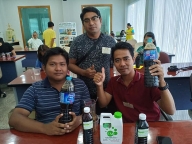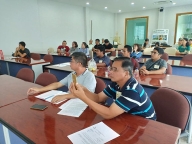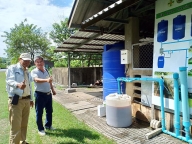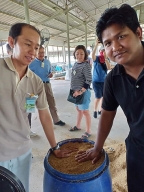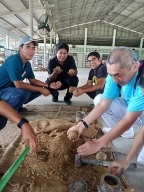Latest News
April 13, 2018 - EM™ for Sewage Treatment
Oct 30, 2018WHY WE NEED TO USE EM IN SEWAGE TREATMENT
Microorganisms are inevitable participants in the cleaning of water in nature. As all of us in our daily lives continue to produce pollutants, it is through the activity of microorganisms that these pollutants are broken down and cleaned.
With the increasing pollution of water systems in recent years, it has been noted that the amount of pollution produced by humans far exceeds the cleaning capacity of nature. The spread of the use of chlorine destroys the critical microorganisms that have self-cleaning functions, a contradiction that intensifies the deterioration of the environment.
Most of the sewage, after going through the sewage treatment system, usually ends up in our rivers, lakes, and oceans. A shortage of water can cause outbreak of diseases, not to mention, the dehydration in people and loss of crops. Most, if not all, of our water can be recycled. That is, tap or potable water from our reservoirs used for drinking and washing which mostly end up in the septic tanks or some sort of sewage treatment facility can be recycled back into toilets and for general purpose cleaning: washing cars, streets, the home, the place of work, watering lawns, gardens, and house plants. This not only represents avoidance of "water shortage emergencies", but also a great savings in costs.
EM™ can greatly help accomplish the above recycling, including considerable reduction, if not elimination, of foul odour, sludge, and the cleaning of our rivers, lakes, and oceans. EM™ prevents corrosion through the suppression of activities of free radicals and therefore prevents the deterioration of the sewer system and tanks. This would translate into long term savings in maintenance cost. As EM™ pervades throughout the sewer system and into the rivers, lakes, and oceans, EM™ creates a condition in which plant life can propagate. And such revitalization of plant life along river banks, shorelines, and sea coasts, can prevent their erosion.
HOW TO APPLY EM IN SEWAGE TREATMENT
1. 1/10,000 EMAS and EM PB per water volume.
Microorganisms are inevitable participants in the cleaning of water in nature. As all of us in our daily lives continue to produce pollutants, it is through the activity of microorganisms that these pollutants are broken down and cleaned.
With the increasing pollution of water systems in recent years, it has been noted that the amount of pollution produced by humans far exceeds the cleaning capacity of nature. The spread of the use of chlorine destroys the critical microorganisms that have self-cleaning functions, a contradiction that intensifies the deterioration of the environment.
Most of the sewage, after going through the sewage treatment system, usually ends up in our rivers, lakes, and oceans. A shortage of water can cause outbreak of diseases, not to mention, the dehydration in people and loss of crops. Most, if not all, of our water can be recycled. That is, tap or potable water from our reservoirs used for drinking and washing which mostly end up in the septic tanks or some sort of sewage treatment facility can be recycled back into toilets and for general purpose cleaning: washing cars, streets, the home, the place of work, watering lawns, gardens, and house plants. This not only represents avoidance of "water shortage emergencies", but also a great savings in costs.
EM™ can greatly help accomplish the above recycling, including considerable reduction, if not elimination, of foul odour, sludge, and the cleaning of our rivers, lakes, and oceans. EM™ prevents corrosion through the suppression of activities of free radicals and therefore prevents the deterioration of the sewer system and tanks. This would translate into long term savings in maintenance cost. As EM™ pervades throughout the sewer system and into the rivers, lakes, and oceans, EM™ creates a condition in which plant life can propagate. And such revitalization of plant life along river banks, shorelines, and sea coasts, can prevent their erosion.
HOW TO APPLY EM IN SEWAGE TREATMENT
1. 1/10,000 EMAS and EM PB per water volume.
April 13, 2018 - EM™ for Household
Oct 30, 2018WHY WE NEED TO USE EM IN HOUSEHOLD
Cleaning
The widespread use of antiseptic cleaners and health products has come under closer scrutiny in recent years. These antibiotic products are designed to destroy all bacteria, whether they are beneficial or harmful. The healthy and beneficial microflora is what sustains biodiversity in our environments. Hence, the antiseptic approach of destroying all bacteria often worsens a situation by attempting to treat the symptoms rather than alleviating the cause. On the other hand, using the all-natural EM™ allows the microbial diversity to form alliances, which restrict and suppress the growth of the "bad bugs". This allows for a healthy defence system of the "good bugs" to revitalize and refresh their environment. EM™ is designed to build strong probiotic alliances to form a healthy immune system for the soil, plants, animals, and humans. For creating a clean and healthy environment, we like to say that "Nature Does It Best!"
Bleachers and synthetic detergents are commonly used to deal with ingrained g rease, stains and mould in house. However, their chemical components can be absorbed into the body through skin and cause physical problems such as an intestinal trouble and allergy. Moreover, they lead to an environmental pollution when they are flowed into rivers.
On the other hand, EM™ works great as environmentally-safe degreasers and all-purpose cleaners. It is especially useful as a cleaning or deodorizing agent due to its antioxidant qualities and ability to eat grease.
EM™ can be used to reduce and eliminate odour in carpets, furniture, trash, etc. It can also be used to used to clean windows, mirrors, toilets, tubs, flooring, etc.

.png)
clean windows, mirrors, toilets, tubs, flooring, etc.
Cleaning
The widespread use of antiseptic cleaners and health products has come under closer scrutiny in recent years. These antibiotic products are designed to destroy all bacteria, whether they are beneficial or harmful. The healthy and beneficial microflora is what sustains biodiversity in our environments. Hence, the antiseptic approach of destroying all bacteria often worsens a situation by attempting to treat the symptoms rather than alleviating the cause. On the other hand, using the all-natural EM™ allows the microbial diversity to form alliances, which restrict and suppress the growth of the "bad bugs". This allows for a healthy defence system of the "good bugs" to revitalize and refresh their environment. EM™ is designed to build strong probiotic alliances to form a healthy immune system for the soil, plants, animals, and humans. For creating a clean and healthy environment, we like to say that "Nature Does It Best!"
Bleachers and synthetic detergents are commonly used to deal with ingrained g rease, stains and mould in house. However, their chemical components can be absorbed into the body through skin and cause physical problems such as an intestinal trouble and allergy. Moreover, they lead to an environmental pollution when they are flowed into rivers.
On the other hand, EM™ works great as environmentally-safe degreasers and all-purpose cleaners. It is especially useful as a cleaning or deodorizing agent due to its antioxidant qualities and ability to eat grease.
EM™ can be used to reduce and eliminate odour in carpets, furniture, trash, etc. It can also be used to used to clean windows, mirrors, toilets, tubs, flooring, etc.

.png)
clean windows, mirrors, toilets, tubs, flooring, etc.
April 13, 2018 - EM™ for Wellness & Health
Oct 30, 2018WHY WE NEED TO USE EM IN MAINTAINING OUR WELLNESS AND HEALTH
When we talk about preventive medicine the basic key to being healthy is to strengthen your natural healing power. Therefore, we need to help return our environment (soil, water, air) to a healthy, natural state.
EM Technology™ combines the beneficial and fermentative microorganisms that exist throughout nature, and integrates the force of natural healing power and immune strength that exists in humans and the environment. When the environment becomes healthy, so will human beings.
EM Technology™ - Beneficial Bacteria and Antioxidants for Optimum Health
EM™ with its naturopathic nature is a good source of supplement for promoting better health. Its benefits include:
.jpg)
EM-X® Gold contains highly bio-available EM® -derived enzymes that generate highly beneficial metabolic fermentation byproducts. These metabolites include trace minerals, vitamins, beneficial bacteria and healthy enzymes.
When we talk about preventive medicine the basic key to being healthy is to strengthen your natural healing power. Therefore, we need to help return our environment (soil, water, air) to a healthy, natural state.
EM Technology™ combines the beneficial and fermentative microorganisms that exist throughout nature, and integrates the force of natural healing power and immune strength that exists in humans and the environment. When the environment becomes healthy, so will human beings.
EM Technology™ - Beneficial Bacteria and Antioxidants for Optimum Health
EM™ with its naturopathic nature is a good source of supplement for promoting better health. Its benefits include:
- The broad array of beneficial bacteria and trace minerals helps promotes balanced and healthy digestive and immune systems
- EM™-derived enzymes generate beneficial bacteria, trace minerals, vitamins and healthy enzymes needed by human body, and
- EM™ is rich in antioxidants which could neutralise the formation of free radicals, one of the main source of cancer.
.jpg)
EM-X® Gold contains highly bio-available EM® -derived enzymes that generate highly beneficial metabolic fermentation byproducts. These metabolites include trace minerals, vitamins, beneficial bacteria and healthy enzymes.
April 13, 2018 - EM™ for Disaster Relief
Oct 30, 2018EM™ is often used to solve problems raised in areas affected by disasters. When the municipal water supply is disrupted in post disaster condition, EM™ is able to prove its effectiveness in sanitary measures including odor control and cleaning up of affected areas to curb the spread of pathogen diseases.
EM™ is recently used in the Thailand flood which inundated Bangkok and most of Thailand’s South to clean up the affected areas. EM™ was also used in Japan after it was hit by the Tsunami and Earthquake that struck the north-east part of the country on 11th March 2011. Other EM™ applications for disaster relief include:-
EM™ is recently used in the Thailand flood which inundated Bangkok and most of Thailand’s South to clean up the affected areas. EM™ was also used in Japan after it was hit by the Tsunami and Earthquake that struck the north-east part of the country on 11th March 2011. Other EM™ applications for disaster relief include:-
- EM™ was applied after the Johor flood in Kota Tinggi in year 2007 to improve the hygienic condition.
- It was also used extensively in Thailand, Indonesia, and other countries which suffered from the Tsunami Wave Disaster caused by the devastating earthquake occurred off the west coast of Sumatera, Indonesia in 2004.
- It was used by the German government after the Elbe River flood disaster in 2002 to remediate the standing toxic water and contaminated drainage sites.
- EM™ has also been used for decontaminating the polluted inland seas of Japan and China as well as other bioremediation projects around the world – where marine life and vegetation have significantly returned.
April 13, 2018 - HISTORY OF EM™ TECHNOLOGY
Oct 30, 2018EM Technology™ was developed over 35 years ago by Professor Dr. Teruo Higa from the University of Ryukyus, Okinawa, Japan. As an agriculturist, Dr. Teruo Higa was testing a variety of microorganisms, where he accidentally fell upon a blend of microscopic organisms that had formed a symbiotic alliance which is capable of positively influencing decomposing organic matter and turn it into a "life promoting" process, i.e. The wastes from one become the food for the other. Dr. Higa then decided to name his discovery “Effective Microorganisms”, which is now popularly referred to as EM. EM was originally considered as an alternative for agricultural chemicals. Today, EM is produced in more than 50 countrie and distributed to more than 130 countries around the world. EM is not only applied to enhance sustainable agriculture, but also for environmental, industrial and human health.
Nature’s Little Recyclers
Due to the regenerative capability of these microbes to consume toxins and produce beneficial by-products such as vitamins, enzymes, organic acids, bioactive minerals, and antioxidants, they are sometimes referred to as “nature’s little recyclers”.
Dr. Higa background and His Philosophy

Dr. Higa’s Background
Dr. Teruo Higa was born in 1941 in the Okinawa prefecture. He graduated from the Department of Agriculture, College of Agriculture from the University of the Ryukyus, where he then pursued his Doctorate study at the Agriculture Research Department at Kyushu University. Dr. Higa later joined University of the Ryukyus as a Professor in 1982 and he is also the director at the International EM Technology Center of Meio University in Okinawa, Japan. Known internationally for developing " EM Technology™", Dr. Higa has been actively involved in its instruction in various countries.
Philosophy
The industrialization in our world now is creating more competitions than ever for the scarce resources, which has resulted in an outbreak of serious global problems such as air pollution and food shortages. In contrast, the fundamental belief in Dr. Higa’s philosophy is 'creating a society based on co-existence and co-prosperity' to solve these global issues.
Dr. Higa believes that the positive traits that exists in EM plays a key role to tackle problems regarding to food supply, environmental preservation, medical care and energy supply for the establishment of world peace. For example, the application of EM in agriculture eliminates pollution to the environment while providing a supply of high quality food at low cost. The use of EM to recycle kitchen and animal wastes helps reduces environmental pollution and safeguarding human health.
Concept of Technology
Dr. Higa invokes a "dominance principle" to explain the effects of EM. He claims that three groups of microorganisms exist: "positive microorganisms" (regeneration – microbes that heal, restore and enliven), "negative microorganisms" (decomposition, degeneration – microbes that break down, decompose and putrefy), and "opportunist microorganisms". In every medium (soil, water, air, the human intestine), the ratio of "positive" and "negative" microorganisms is critical, since the opportunist microorganisms tend to follow the lead of whichever alliance that establishes dominance. Therefore, Dr. Higa believes that it is possible to positively influence the given media by increasing the ratio of the "positive" microorganisms.
.png)
Nature’s Little Recyclers
Due to the regenerative capability of these microbes to consume toxins and produce beneficial by-products such as vitamins, enzymes, organic acids, bioactive minerals, and antioxidants, they are sometimes referred to as “nature’s little recyclers”.
Dr. Higa background and His Philosophy

Dr. Higa’s Background
Dr. Teruo Higa was born in 1941 in the Okinawa prefecture. He graduated from the Department of Agriculture, College of Agriculture from the University of the Ryukyus, where he then pursued his Doctorate study at the Agriculture Research Department at Kyushu University. Dr. Higa later joined University of the Ryukyus as a Professor in 1982 and he is also the director at the International EM Technology Center of Meio University in Okinawa, Japan. Known internationally for developing " EM Technology™", Dr. Higa has been actively involved in its instruction in various countries.
Philosophy
The industrialization in our world now is creating more competitions than ever for the scarce resources, which has resulted in an outbreak of serious global problems such as air pollution and food shortages. In contrast, the fundamental belief in Dr. Higa’s philosophy is 'creating a society based on co-existence and co-prosperity' to solve these global issues.
Dr. Higa believes that the positive traits that exists in EM plays a key role to tackle problems regarding to food supply, environmental preservation, medical care and energy supply for the establishment of world peace. For example, the application of EM in agriculture eliminates pollution to the environment while providing a supply of high quality food at low cost. The use of EM to recycle kitchen and animal wastes helps reduces environmental pollution and safeguarding human health.
Concept of Technology
Dr. Higa invokes a "dominance principle" to explain the effects of EM. He claims that three groups of microorganisms exist: "positive microorganisms" (regeneration – microbes that heal, restore and enliven), "negative microorganisms" (decomposition, degeneration – microbes that break down, decompose and putrefy), and "opportunist microorganisms". In every medium (soil, water, air, the human intestine), the ratio of "positive" and "negative" microorganisms is critical, since the opportunist microorganisms tend to follow the lead of whichever alliance that establishes dominance. Therefore, Dr. Higa believes that it is possible to positively influence the given media by increasing the ratio of the "positive" microorganisms.
.png)
April 13, 2018 - What Is EM™?
Oct 30, 2018
EM stands for "Effective Microorganisms™". EM consists of a mixed culture of beneficial and naturally-occurring microorganisms most used or found in food industry and agriculture. EM is produced through a natural process and not chemically synthesized and not genetically modified (non-GMO).
Microorganisms in EM
EM is made up of three main genera: lactic acid bacteria, yeast, and phototropic bacteria. These effective microorganisms create beneficial substances such as vitamins, organic acids, chelated minerals and anti-oxidants when in contact with organic matter.

.png)
1. Lactic Acid Bacteria
Lactic acid bacteria convert sugar and other source into lactic acid. Through the production of lactic acid, lactic acid bacteria also inhibit the growth of pathogenic microorganisms. Lactic acid bacteria have been noted for its beneficial effects on health and longevity and it is widely used in making fermented foods such as cheese, yogurt and pickles.
.png)
2. Yeast
A fermentation starter necessary for making bread. Yeast live in sugar-rich environments such as in nectar and the surface of fruits. In EM•1®, yeast produces many bio-active substances such as amino acids and polysaccharides.
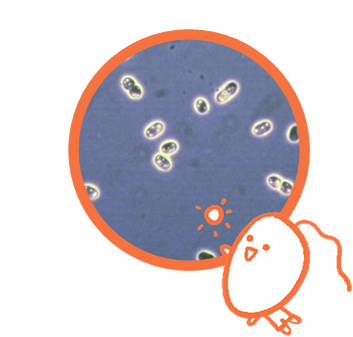
3. Phototrophic Bacteria
Phototrophic bacteria utilize solar energy to metabolize organic and inorganic substances and play a major role in nitrogen cycling and carbon cycling. Being one of the oldest living organisms on the planet, it is the essential element of EM because of its ability to balance the other microorganisms to allow them to co-exist.
Microorganisms in EM
EM is made up of three main genera: lactic acid bacteria, yeast, and phototropic bacteria. These effective microorganisms create beneficial substances such as vitamins, organic acids, chelated minerals and anti-oxidants when in contact with organic matter.

.png)
1. Lactic Acid Bacteria
Lactic acid bacteria convert sugar and other source into lactic acid. Through the production of lactic acid, lactic acid bacteria also inhibit the growth of pathogenic microorganisms. Lactic acid bacteria have been noted for its beneficial effects on health and longevity and it is widely used in making fermented foods such as cheese, yogurt and pickles.
.png)
2. Yeast
A fermentation starter necessary for making bread. Yeast live in sugar-rich environments such as in nectar and the surface of fruits. In EM•1®, yeast produces many bio-active substances such as amino acids and polysaccharides.

3. Phototrophic Bacteria
Phototrophic bacteria utilize solar energy to metabolize organic and inorganic substances and play a major role in nitrogen cycling and carbon cycling. Being one of the oldest living organisms on the planet, it is the essential element of EM because of its ability to balance the other microorganisms to allow them to co-exist.
June 9, 2018 - EM RECIPE, EMAS & EM MUDBALL
Oct 30, 2018EM RECIPE
How to activate EM•1®
(**Activated EM•1 is called EM Activated Solution “EMAS “)
Materials
.png)
Points to note:
• EM likes warm conditions.
A suitable temperature for fermentation (propagation) of EM•1 is from 30°C to 40°C. In the winter, and other times when the temperature is low, after making the Activated EM•1 (dissolving the molasses in hot water), place the EM next to a radiator, space heater, or other warm device, or even wrap it in a blanket or an insulator, in order to promote EM fermentation.
When is Activated EM•1® ready to use?
Activated EM•1 is ready to use, 7 - 10 days after preparing it, when the pH of Activated EM•1 drops below 3.6 (ideally it has a pH between 3 - 3.5), and when it has a sweet-sour smell and has changed color from black to dark brown. However, please note that there will be some variation in the results of the fermentation of Activated EM•1 due to factors such as; the quality of the water and molasses, the amount of EM•1 and molasses, and temperature differences (water during mixing, room temperature).
USE:
Ideally, it is best to use Activated EM•1 within a week after Activated EM•1 is ready (after the pH is below 3.6). The effective microorganisms in Activated EM•1 are very active and powerful during this period. You can use Activated EM•1 for up to one month after it is ready. However, the microbial effects of Activated EM•1 are not as great as when it is "young".
Storage
Activated EM•1 should be kept in an expandable air-tight container to keep it anaerobic. Store Activated EM•1 at room temperature 20°C to 30°C. Refrigeration is not necessary. In containers that are not totally airtight, a white layer of yeast bacteria may form on the surface. Since this may lead to putrefaction, remove the layer as needed and transfer to a container that can be closed tightly. If stored Activated EM•1 has a foul smell or the pH rises above 4.0, the solution could be contaminated with undesirable microbes and should be discarded. It is fine to pour this material on a long-term compost pile.
Uses for Activated EM•1:
From domestic use to Cleaning up the environment
✔Use quality EM・1
✔Clean air-tight container
✔Clean water
✔Sweet and uncontaminated molasses.
✔keep in a warm place during fermentation
ideal temperature is 20-35¡æ
✔Keep anaerobic condition
Checklists for Quality EMAS:
Fermentation period - 7-10 days£¨depends on temperature£©
2. How to prepare EM™ Mudballs
Materials
For 10,000 EM Mudball (100m X 100m area)
-1500kg Soil- Clay-like-soil. Easy to form balls.
-150kg EM Bokashi
-500L Activated EM•1 (EMAS).
- EM Ceramics Powder may be added- Optional
-Charcoal powder (5-10%) -Optional
Note:
Since the water content of the soil used will vary, the amount of Activated EM•1 (EMAS) will vary as well. As a general rule, though, if for instance you produce 15 liters of material you will need approximately 1 liter/quart of Activated EM•1 (EMAS). Always be sure to have enough Activated EM•1 (EMAS) on hand in case it is needed. If you use it up, you can add extra water instead (don’t be afraid to use a lot of Activated EM•1).
The amount of optional EM Ceramics Powder will be between 0.1% of the total amount. For example, for 10 liters of material this will equal 10 gram of EM Ceramics Powder.
How to activate EM•1®
(**Activated EM•1 is called EM Activated Solution “EMAS “)
Materials
- Water 400 ml
- Molasses 20 - 25 ml
- (or brown sugar 20 - 25 gm)
- EM•1 20 - 25 ml
- 500-ml bottle
- Pour 400 ml of water into a measuring cup.
- Add 20 - 25 ml of molasses (or 20 - 25 gm of brown sugar). Mix well.
- Add in 20 - 25 ml of EM•1®. Mix well.
- Pour all contents into the plastic bottle. Make sure to leave about 10% air space.
- Keep the bottle tightly closed and leave in a warm place (i.e. 20 - 40oC) for 7 – 10 days.
- Loosen the cap a few times over the 10 days to release pent-up gas.
- When gas formation stops, the fermentation process is complete.
- Store in a cool dark place.
- Use within 1 month according to the dilutions below:
.png)
Points to note:
- Check to make sure the cap is always closed tightly for both EM•1 and EMAS. When air enters during the fermentation stage, unwanted microbes can enter and begin putrefying the contents.
- DO NOT use a glass bottle for making EMAS as the pent-up gas may lead to an explosion.
- To check for quality, ensure that the pH is below pH 3.6. The smell should be sweet-sour.
- After opening the bottle of EM•1, white flakes may appear on the surface of the liquid. This is yeast and is harmless.
- Discard if the pH rises above 4 or if there is a foul smell.
- To ensure the quality, we do not recommend to use a 2nd generation of EMAS or further generation.
• EM likes warm conditions.
A suitable temperature for fermentation (propagation) of EM•1 is from 30°C to 40°C. In the winter, and other times when the temperature is low, after making the Activated EM•1 (dissolving the molasses in hot water), place the EM next to a radiator, space heater, or other warm device, or even wrap it in a blanket or an insulator, in order to promote EM fermentation.
When is Activated EM•1® ready to use?
Activated EM•1 is ready to use, 7 - 10 days after preparing it, when the pH of Activated EM•1 drops below 3.6 (ideally it has a pH between 3 - 3.5), and when it has a sweet-sour smell and has changed color from black to dark brown. However, please note that there will be some variation in the results of the fermentation of Activated EM•1 due to factors such as; the quality of the water and molasses, the amount of EM•1 and molasses, and temperature differences (water during mixing, room temperature).
USE:
Ideally, it is best to use Activated EM•1 within a week after Activated EM•1 is ready (after the pH is below 3.6). The effective microorganisms in Activated EM•1 are very active and powerful during this period. You can use Activated EM•1 for up to one month after it is ready. However, the microbial effects of Activated EM•1 are not as great as when it is "young".
Storage
Activated EM•1 should be kept in an expandable air-tight container to keep it anaerobic. Store Activated EM•1 at room temperature 20°C to 30°C. Refrigeration is not necessary. In containers that are not totally airtight, a white layer of yeast bacteria may form on the surface. Since this may lead to putrefaction, remove the layer as needed and transfer to a container that can be closed tightly. If stored Activated EM•1 has a foul smell or the pH rises above 4.0, the solution could be contaminated with undesirable microbes and should be discarded. It is fine to pour this material on a long-term compost pile.
Uses for Activated EM•1:
From domestic use to Cleaning up the environment
- Improving soil quality for healthy plants.
- Eliminating foul odor.
- Keeping your drain clean.
- EM•1 eliminates odor so, it can be used for cleaning in the home.
- Dilute EM•1 or Activated EM•1 with water (1:500 dilution) then use it for cleaning.
- A half cup in the washing machine can help clean the clothes.
- The EM•1 in the water draining into your pipes will work on cleaning the sewer lines.
- A half cup in a vaporizer will remove odors in the home (cigarettes, wet dog smell, food).
- Clean the bathroom with it too. Have spray bottle handy and spray into the sink, shower, and toilet after each use. (1:500 dilution).
✔Use quality EM・1
✔Clean air-tight container
✔Clean water
✔Sweet and uncontaminated molasses.
✔keep in a warm place during fermentation
ideal temperature is 20-35¡æ
✔Keep anaerobic condition
Checklists for Quality EMAS:
Fermentation period - 7-10 days£¨depends on temperature£©
- pH - Should drop to below 3.6
- Smell - Sweet-sour fermentation smell£¨Unpleasant smell means failure of the process£©
- Color - Dark brown turns into a lighter brown
- Gas formation - Generally stops when fermentation is completed
2. How to prepare EM™ Mudballs
Materials
- Soil. It is usually better to use clay-soil that can easily be formed into balls.
- Activated EM•1.
- Molasses (At 10% the volume of the Activated EM•1)
- EM Bokashi.
- Use EM Mudballs in river bottoms and mud flats where slime has accumulated. Generally, use one EM Mudball for each square meter (1m X 1 m) of the polluted area.
- Use EM Mudballs once each season until results are seen.
- Cleaning up oceans, rivers, lakes and ponds requires the application of EM into the water through a variety of methods. It is recommended that Activated EM•1 also be regularly applied into the water to supplement the use of EM Mudballs.
For 10,000 EM Mudball (100m X 100m area)
-1500kg Soil- Clay-like-soil. Easy to form balls.
-150kg EM Bokashi
-500L Activated EM•1 (EMAS).
- EM Ceramics Powder may be added- Optional
-Charcoal powder (5-10%) -Optional
Note:
Since the water content of the soil used will vary, the amount of Activated EM•1 (EMAS) will vary as well. As a general rule, though, if for instance you produce 15 liters of material you will need approximately 1 liter/quart of Activated EM•1 (EMAS). Always be sure to have enough Activated EM•1 (EMAS) on hand in case it is needed. If you use it up, you can add extra water instead (don’t be afraid to use a lot of Activated EM•1).
The amount of optional EM Ceramics Powder will be between 0.1% of the total amount. For example, for 10 liters of material this will equal 10 gram of EM Ceramics Powder.
August 1, 2018 - Asia Pacific Natural Agriculture Network (APNAN) International Workshop
Oct 30, 2018
View Full Size
Malaysian Participant were welcomed into Saraburi Kyusei Natural Farming Centre,Thailand for Asia Pacific Natural Agriculture Network(APNAN) International Workshop.
Day 1
1. Concept of Nature Farming
2. Basic Info on EM
3. Field Visit to Saraburi Farm
4. EM Activated Solution (EMAS) & EM Fermented Plant Extract (EMFPE) Class
Day 1
1. Concept of Nature Farming
2. Basic Info on EM
3. Field Visit to Saraburi Farm
4. EM Activated Solution (EMAS) & EM Fermented Plant Extract (EMFPE) Class
August 1, 2018 - APNAN Workshop
Oct 30, 2018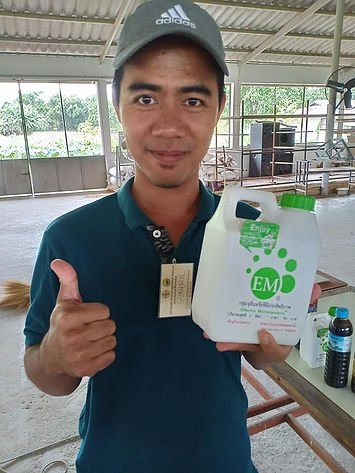
View Full Size
APNAN Workshop Day 2!
1. EM Bokashi & EM Mudball Class
2. EM Bokashi & EM Mudball Practical
3. Crop Management Class
4. Land Preparation Practice
5. Mushroom Cultivation
6. Visits Sekai Kyusei Kyo Sacred Ground
7. Closing Ceremony
1. EM Bokashi & EM Mudball Class
2. EM Bokashi & EM Mudball Practical
3. Crop Management Class
4. Land Preparation Practice
5. Mushroom Cultivation
6. Visits Sekai Kyusei Kyo Sacred Ground
7. Closing Ceremony
August 1, 2018 - Plastics Not Food
Oct 30, 2018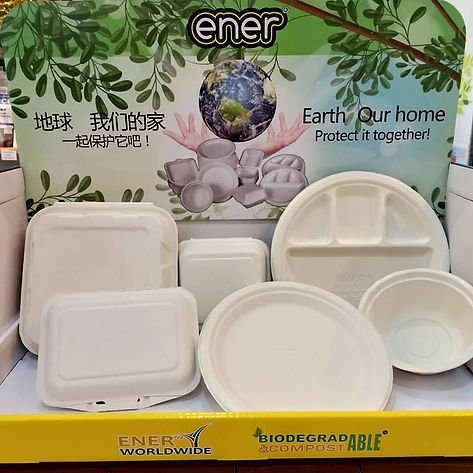
View Full Size
Another good news! 😍 Biodegradable and compostable products are now available at EM Greenlife, our retail shop @ Sutera Mall.
They are made from Sugarcane Bagasse (natural fibers). Hence the food packaging are compostable within 6 month after usage and will not produce any toxic leftovers. Products are made by Ener Worldwide Sdn Bhd.
The plastic we throw are coming back full circle to us in our daily diet. Plastic contaminants are now found worldwide in our drinking water, in seafood and even in sea salt 😫😥 It is time to break-up with single use plastics to save our planet and the eco-system.
Detox our planet! Everyone can do our part 🌱🌿🌾🌏
They are made from Sugarcane Bagasse (natural fibers). Hence the food packaging are compostable within 6 month after usage and will not produce any toxic leftovers. Products are made by Ener Worldwide Sdn Bhd.
The plastic we throw are coming back full circle to us in our daily diet. Plastic contaminants are now found worldwide in our drinking water, in seafood and even in sea salt 😫😥 It is time to break-up with single use plastics to save our planet and the eco-system.
Detox our planet! Everyone can do our part 🌱🌿🌾🌏






